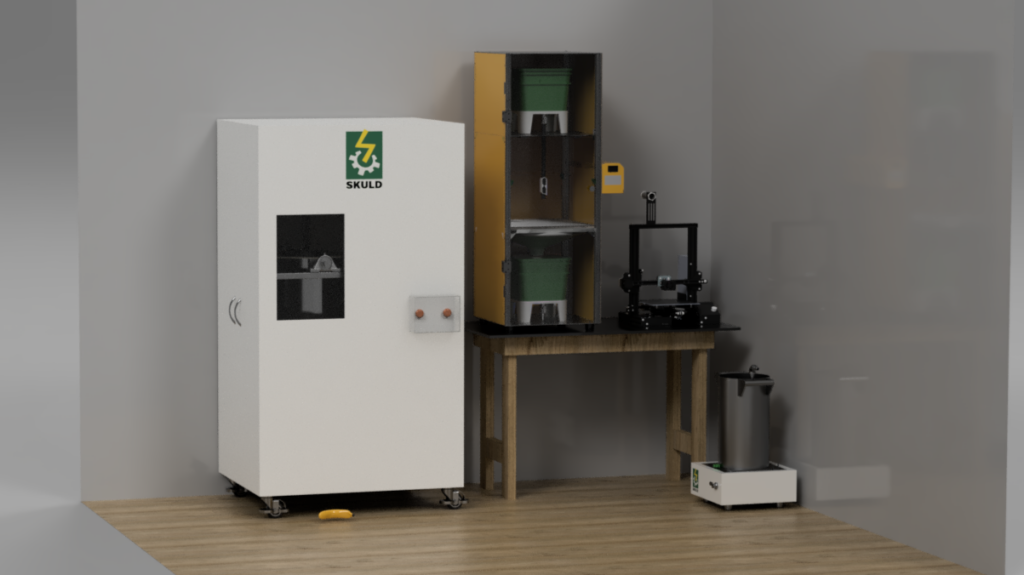Ohio-based Skuld is opening a new foundry with which to further advance its additive manufacturing evaporative casting (AMEC) technology. AMEC is similar to a lost foam casting process, but it leverages 3D printed foam components that are produced on low-cost machines, enabling both cheaper and more precise manufacturing than previously possible. Additionally, this process significantly speeds up production, reducing lead times, which are crucial in casting. The cost of cast parts and reducing lead times are particularly important for the United States. By accelerating the production of low-cost metal parts domestically, the U.S. can potentially revitalize its casting industry, especially for defense and other key sectors.
Now, Skuld will open a new facility in Piqua, Ohio. With a population of 20,000, Piqua is notable for hosting the United States’ first residential nuclear reactor. It also has a propeller factory and several steel businesses. Piqua has a patriotic history, having produced numerous admirals and generals. Previously a hub for underwear and linseed manufacturing, the town also boasts business acumen as the birthplace of a founder of Archer Daniels Midland and Fisher-Price.
However, this new venture isn’t about the kind of manufacturing disruption focused on parts for space or aircraft engines, but rather on the other 95% of components that are more commonplace and much less expensive. The new facility, spanning 32,000 square feet (approximately 3,000 square meters), will be situated on the site of an old iron foundry that closed in 2017. It is designed to manufacture parts from various materials, including steel, iron, aluminum, brass, bronze, copper, and nickel alloys. The plant will feature a print farm with an initial capacity of 3,000 tonnes. The company aims to triple this capacity over the next few years, indicating significant ambitions in terms of volume across multiple material classes.
In addition to 3D printing, the facility will be equipped with a foam blowing machine and heat treatment capabilities. With its AMEC technology, the company intends to reduce the time-to-part to within a day. Such a turnaround time could make this process highly beneficial. Skuld also aspires to be directly cost-competitive with existing casting technologies.
Simultaneously, the company is planning to sell its Lightning Metal systems. This system represents an affordable casting and printing setup that can be purchased and deployed locally. In scenarios like bridge manufacturing, such a setup could be extremely valuable. Additionally, for entities like the military, a locally, forward-deployed, low-cost, one-day metal parts fabrication service could be highly beneficial. Skuld is part of the latest Innovation Crossroads cohort at Oak Ridge National Labs, which typically focus on applying new technology to significant challenges in energy and manufacturing, so such a scenario wouldn’t be so surprising.
Production at the new site is scheduled to begin in April 2024. I am eagerly anticipating seeing this technology more widely deployed. Of course, its effectiveness needs to be verified. However, if it proves successful, it could facilitate the indirect 3D printing of parts in large volumes and at very remote locations. For more insights, you might this super fun episode of the 3DPOD with Skuld’s founder, Sarah Jordan.
Subscribe to Our Email Newsletter
Stay up-to-date on all the latest news from the 3D printing industry and receive information and offers from third party vendors.
Print Services
Upload your 3D Models and get them printed quickly and efficiently.
You May Also Like
3D Printing News Briefs, June 11, 2025: Sustainability, Automotive Tooling, & More
We’re starting with sustainability news in today’s 3D Printing News Briefs, as EOS has strengthened its commitment on climate responsibility, and Zestep is making 3D printing filament out of eyewear...
3D Printing 50 Polymer Stand-In Parts for Tokamaks at the PPPL & Elytt Energy
Of all the world’s things, a tokamak is one of the hardest, most complex, expensive and exacting ones to make. These fusion energy devices make plasma, and use magnets to...
3D Printing News Briefs, May 17, 2025: Color-Changing Materials, Humanoid Robot, & More
We’re covering research innovations in today’s 3D Printing News Briefs! First, Penn Engineering developed 3D printed materials that change color under stress, and UC Berkeley researchers created an open source,...
Firehawk Aerospace Partners with JuggerBot 3D, Gets $1.25M from AFWERX for 3D Printed Propellants
Texas-based Firehawk Aerospace, an advanced energetic materials firm that works with aerospace and defense applications, announced a strategic partnership with JuggerBot 3D, an Ohio-based large-format 3D printer manufacturer. Together, the...



































